The more I study nature, the more I become impressed with ever-increasing force, that the contrivances and beautiful adaptations slowly acquired through each part occasionally varying in a slight degree but in many ways, with the preservation of these variations which were beneficial to the organism under complex and ever-varying conditions of life, transcend in an incomparable manner the contrivances and adaptations which the most fertile imagination of man could invent.
Charles Darwin
10 July, 2025
It's always a pleasure to visit SpruceHaven; on this occasion the pleasure was enhanced by having Pam make her first visit there.
As soon as we stepped out of the car we heard the loud, rollicking song of a House Wren (Troglodytes aedon) and quickly spotted a male close to the first nest box along the trail.
It didn't take us long to learn that he was constructing a nest there, hoping to attract a female and gain her approval.
Common Milkweed (Asclepias syriaca) was both plentiful and beautiful, but we saw nary a Monarch (Danaus plexippus) taking advantage of it.
Creeping Bellflower (Campanula rapunculoides) is a beautiful plant that always commands our admiration.
Several sparrows worked the grassland but mostly they were up and down so quickly they thwarted efforts to identify them. Song Sparrow (Melospiza melodia) was the exception, often trilling its distinctive song as though to announce its name.
Flies (order Diptera) are fascinating and varied, but I need more study and practice to identify many of them.
Seven-spotted Lady Beetle (Coccinella septempunctata) is quite common. Lady beetles in general are looked on with favour even by those who profess not to like insects.
A lady beetle in your garden should be met with thanks since they are ferocious devourers of harmful aphids.
Draeculacephala antica is a type of leafhopper exhibiting colour variation from tan to green, occasionally blue.
Tumbling flower beetles are small wedge-shaped beetles with a distinctive "pintail." They can make small, twisting jumps when disturbed enabling them to escape predators. The following is a Blistered Tumbling Flower Beetle (Mordellina pustulata).
We were very happy to see a couple of Eastern Bluebirds (Sialis sialia) including one feeding young in a nest box.
We did not approach closely since the adult was passing food, barely thrusting its head into the nest box, indicating that the young are advanced and possibly close to fledging. We did not wish to incur the possibility of panicking the nestlings into leaving the next prematurely.
A Sharp-legged Robber Fly (Dioctria hyalipennis) would make a tasty, nutritious snack for a growing bluebird.
Among other insects, however, a robber fly is a fearsome predator. They dart after any other insect that flies by, being very catholic in their choice. Prey is seized with their front legs and paralyzed with a bite.
This beetle is found in the subfamily Chrysomelinae.
of interspecific variability.
Regular readers of my blog will now be familiar with the superbly attractive Margined Calligrapher (Toxomerus marginata).
Virginia Creeper (Parthenocissus quinquefolia) has attached itself to Orchard Grass (Dactylis glomerata).
Ashgrey Blister Beetle (Epicauta fabricii) is capable of causing lesions on human skin, so better to avoid contact.
In sufficient numbers it can also cause significant damage to the foliage of potatoes and other crops.
This impressive green caterpillar is probably that of a Hooded Owlet Moth (genus Cucullia) - but I am not a hundred percent sure!
You will notice in the picture above other beetles with large pincers, but I have been unable to identify them.
Calleida punctata is a species of ground beetle.
Lepyronia coleoptrata is a species of spittlebug native to Europe, introduced into northeast North America.
An American Goldfinch (Spinus tristis) is a familiar species of longstanding association, in stark contrast to some of these insects!
This elegant little chap is an Oblique Streaktail (Allograpta obliqua) attracted to a beautiful flower in the family Asteraceae.
As you will have gathered, identification of some insects to species level is often very difficult, sometimes requiring examination under a microscope.
Here is an individual found in the Fruit, Signal, and Picture-winged Flies (superfamily Tephritoidea)










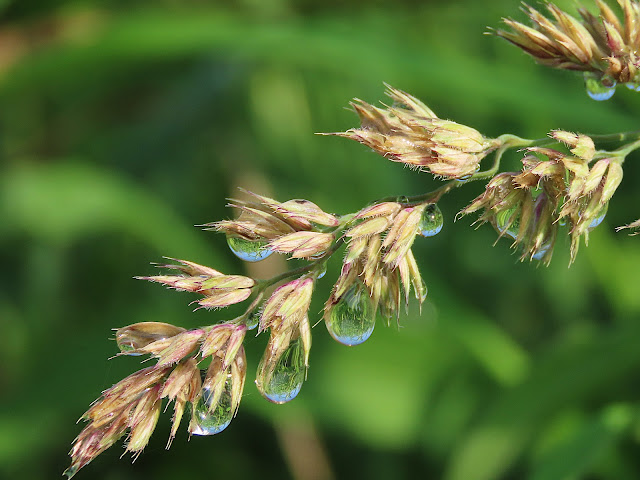






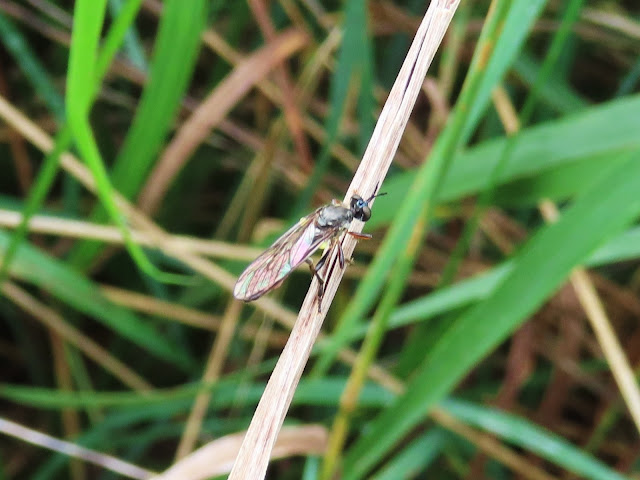
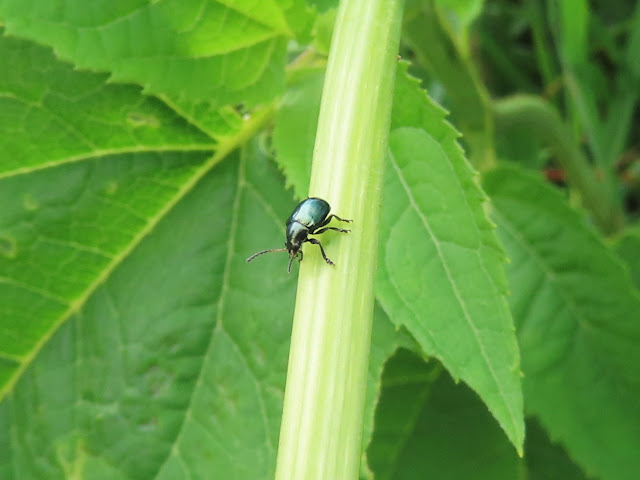






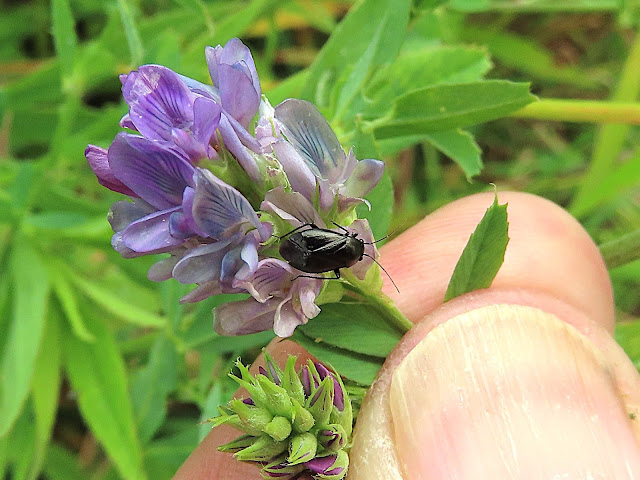






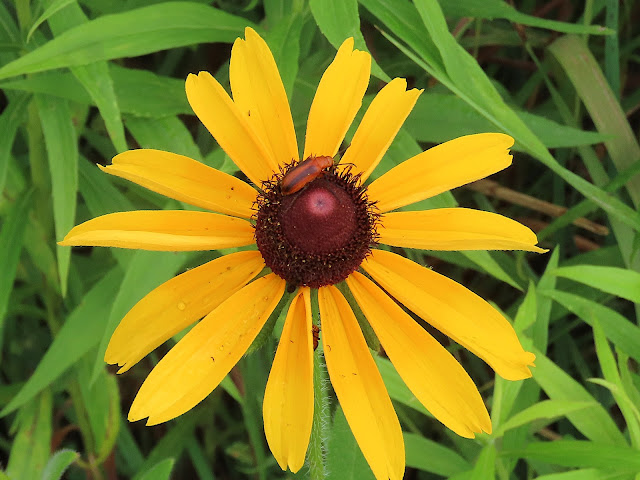






























Hi David.
ReplyDeleteBeautiful series of photos.
Beautiful birds, flowers, and insects.
Those water droplets are very beautiful.
That ash-gray blister beetle is really beautiful.
Greetings from Patricia.
The first thing I noticed today about your blog was the quote by Charles Darwin, David. I wonder what he would have thought about nature in the world today.
ReplyDeleteYes, Rudbeckia hirta is a very beautiful flower. I have grown to love it very much.
Hugs and kisses, Marit
Nunca había oído hablar de la mosca ladrona.
ReplyDeleteTengo muchos cuentos y poemas sobre los animales, me inspiran un montón.
Un abrazo, David.
Dejé una nueva entrada en mi blog.
There is a tradition about ladybugs in Europe: unmarried girls hold a ladybug in their palm, and from the direction in which the ladybug will fly, their husband will come (the respective direction indicates which city he will be from).
ReplyDeleteMight be as effective as any other way to make the right choice!
DeleteThe bluets looks absolutely gorgeous! Love those wild flowers. Thank you for taking us along, David.
ReplyDeleteIt's amazing the number of insects you come upon in one outing! You must have eyes like those of eagles! I love seeing what shows up in my water droplet photos, sometimes there are nice surprises! Your water droplet photo is beautiful!
ReplyDeleteAnother great blog David and I am so enjoying seeing the different bugs that you have there. The Small Milkweed Bug is very similar to our Gendarme beetle though the spots are not quite the same. ID of bugs can be very difficult, and as you say sometimes a microscope would help. I sold my microscope when I left Rhodesia, not sure I would know how to use one anymore!! Bisous mon ami, Diane
ReplyDeleteI haven’t used a microscope in over thirty years, Diane, but I wouldn’t mind giving it a go again. I was always amazed at what I saw.
DeleteI agree you certainly see things that the naked eye would never pick up. xx
Delete...David, life is all about the details and you captured them beautifully!
ReplyDeleteThank you, Tom.
DeleteHari OM
ReplyDeleteJust gorgeous! The 'horned beetle' I rather think might actually be earwigs - I can spot both male and female pincer formations in the bundle... YAM xx
I think you may be right, YAM. Good eyes!
DeleteGreat photos, I like especially those of the red-winged blackbird and the American goldfinch. But of course, all the invertebrate ones are cool too. The Japanese beetles are also invading Europe, and last year, their presence has already been recorded in Germany. I believe Switzerland has been dealing with them for almost a decade now. Lovely looking but nasty little critters. We call them "listokazi", or "leaf-spoilers", in the Czech langauge.
ReplyDeleteAn appropriate name for them.
DeleteI've been enjoying all these insects this season David. Except the Japanese beetles. This year I purchased one of those bags you hang that has a scented pellet you put inside. It's been working great. Usually I spend too much time pulling them off my roses and especially off my grapevine. And I can see why so many insects are attracted to milkweed because those flowers smell amazing. And it's such a strong scent too. Nice photo with the horde on the blossom. No more baby bluebirds in my nest. I guess the pair is done for the season but they did have 2 successful broods. Thanks for sharing these great photos. The song sparrows will no doubt keep me company at the boat ramp tomorrow morning, which is definitely better than the sound of the outboard/inboard motors. Enjoy the rest of your weekend.
ReplyDeleteLots of beauties! So many intricate patterns and colours.
ReplyDeleteI thought they were earwigs in the milkweed as well, having done battle with them so much in the garden!
Hi David, excellent photos of your visit to Sprucehaven. Have a nice visit.
ReplyDeleteAbsolutely gorgeous and captivating series of captures.
ReplyDeleteInsects are so weirdly wonderful, so varied and exotic.
ReplyDeleteThe Japanese beetles and the creeping bellflower have something in common. Both are invasive! We're battling the latter in our yard and I sincerely doubt we'll ever win as it is throughout this entire community, in the yards, alleys and other public spaces.
ReplyDeleteOnce invasive species get established they are extremely difficult to eradicate - sometimes impossible.
DeleteYou sure have had an excellent adventure.
ReplyDeleteWhat a wonderful series. I enjoyed seeing the beetles and the garden spider reminded me of one I once watched from the kitchen window while washing dishes. They are impressive.
ReplyDeleteEine tolle und interessante Fotoserie von den Blüten und deren kleinen Bewohner die im
ReplyDeleteSommer zu finden sind.
Gruß
Noke
So much to see and enjoy and you both capture it all. Very nice post and photos, thank you.
ReplyDeleteMarvelous series and so many interesting insects, gorgeous flowers and grasses. The one with the water droplets was incredible but then I would use that word with all your photos.
ReplyDeleteHello David,
ReplyDeleteI learned a lot again reading your post. Picture 37 could be a tropical melon fly (Bactrocera cucurbitae) or an oriental fruit fly (Bactrocera dorsalis)?
Greetings, Frank
This trip was a great adventure!...I love the pictures!!.........Abrazotes, Marcela
ReplyDelete"As you will have gathered, identification of some insects to species level is often very difficult..."
ReplyDeleteIt's a difficulty you've definitely overcome!
Birds, flowers, spiders, to beetles - wonderful to see.
ReplyDeleteGreat to see nature in all its' SpruceHaven Glory here
ReplyDeleteBeautiful photo series, David.
ReplyDeleteThe singing wren and the water droplets are my favorites this time.
I wish you a wonderful week.
Best regards Irma
A zoom in your eye...or camera ;)
ReplyDeleteAn encyclopedia in your brain
And a blog to show us the wonders of Nature !
Thanks David !
Have an interesting week !
Bisous
Anna
Dear David,
ReplyDeleteI truly enjoyed wandering through this enchanting landscape with you – it actually reminded me a lot of a place called Blockheide, a heathland area here in Austria, where we just recently spent a short holiday with our grandson. (This little trip is also the reason why I'm getting back to you so late.)
I understand what you wrote to me about being an "old-fashioned birder"; I remember you once told me that you were drawn to nature topics from an early age and gathered quite a bit of knowledge even back then.
In contrast, I grew up in the city – and although my parents often took me to the Vienna Woods or other natural areas, they weren't particularly knowledgeable about birds or insects. I grew up recognizing pigeons, sparrows, and blackbirds – and for many years, those were the only birds I could name. It was similar with insects: ladybugs, stag beetles, a few types of butterflies – that was about it. (And, as you know, I was more interested in colors and painting.)
Over time, I gradually added maybe a couple of dozen birds to my “mental list” – but it wasn't until I moved to the countryside (or until I retired) that I truly developed the desire to identify birds more accurately. The Merlin app has been a great help in that regard – now I can finally tell what I’m hearing, and it’s such a fun way to learn!
Warmest wishes from Austria,
Traude 🌿
Hi, Traude : Take a look at the previous post. The Mill Race is a place we will take you when you are here in September.
DeleteJaka piękna i różnorodna łąka! Uwielbiam takie klimaty!
ReplyDeleteTaka teraz obfitość owadów. Zainteresowały mnie tez rośliny, które rosną u nas jedynie w ogrodach.
Hi David - wonderful shots with descriptions ... I think if you want to be a purveyor (probably not the right word) of all tiny living things around our lives, one would need to start v young - so many to distinguish: you do a great job for us. The jewel flies are beautiful ... and I'm always amazed at nature's colours and how they're produced for us to see. Sprucehaven - gorgeous place to enjoy with you - thank you ... cheers Hilary
ReplyDeleteI started when I was eight years old, Hilary, but my skills are still woefully lacking.
DeleteWow... how many details, which you found again. I love this calm in each photo. The spiders are not my friends indeed... but I admire the net of this special spider. And I must say: the nature is wonderful!
ReplyDeleteYou present the beautiful side of the insect world!
ReplyDeleteMy favorite part of summer is trying to capture photos of very cool insects. My interest was peeked when a 9 yr old neighbor girl and I started hunting for them together. At the time it was she who was fascinated by insects and shared her 9 yr old view of them. It got me hooked.
ReplyDeleteYou have some lovely looking beetles over there. I liked the comment you posted on my Ladybird post and you've said it again! People love this beetle! And yes so very helpful. Loving the spiders too :-D
ReplyDeleteJapanese beetles love my marigolds and purple sweet potato vine. I tried collecting some in a jar of soapy water. Hardly made a dent in their population.
ReplyDeleteYou are amazing with your photos of insects and their identification!
They are very difficult, if not impossible to eradicate.
DeleteSeeing a ladybug always makes me smile! You've seen some neat spiders and small insects this summer. I'll be happy when the weather improves here and I can get outside more. Enjoy your week!
ReplyDeleteI think ladybugs elicit that reaction from everyone, unless swarms of them have overwintered in your house!
DeleteLooks a very nice and interesting visit to Sprucehaven.
ReplyDeleteAll the best Jan
Excellent photos and I like the variety of insects you found.
ReplyDeleteI took my malware bytes off my computer so now I can visit your blog again. Delighted to be by and see the wonderful glories of Sprucehaven. These have been hot days for hikes. I hope you've been hydrating!
ReplyDeleteSmashing Sprucehaven in summer, is a marvel, this walk among wings and songs, dear Prof. David! there's so much beauty in the countryside, but I have to say, the beetles steal the show. There are a variety of shapes, sparkles, and names, i like them a lot.
ReplyDeleteBig kiss & happy new week!
I really love this post, David, full of beauty and wonder of insects. I like the beautifully- colored shiny wings of Margined Calligrapher you captured. The Japanese beetle is not well-known here in Japan perhaps because they have more natural enemies in Japan.
ReplyDeleteYoko
I think that is exactly the point, Yoko. Once they are removed from their predators they thrive. They have certainly become a problem, here.
DeleteYour photos are always a pleasure to look at. They are truly stunning. Thank you very much.
ReplyDeleteBirds, plants, and insects.
ReplyDeleteThey all contribute in some way to the perfection and beauty of the environment that surrounds us.
And what a wonder it is to contemplate them.
Best wishes,
JR
Oh my gosh that house wren, so sweet. Once again, thanks for letting us tag along on this wondrous adventure.
ReplyDeleteKiitos David, olipa ihanaa taas kerran tutkia blogipostauksesi kuvia (ja tekstejä) sekä haltioitua niistä!
ReplyDeleteOhhh Mr. M. and I spent some time looking at the purple beetle. LOL Wonderful photos, David.
ReplyDeleteYour blog is always such a source of knowledge on even the smallest details, David. So very many thousands of species that we can miss. Thanks for that.
ReplyDeleteXO
WWW
There are so many different beetles and bugs. It is neat how some of them are so common, like the lady beetles, and they even help out in the garden.
ReplyDeleteWhat a wonderful insect post, David! They are such fascinating little creatures, but overlooked so often. I'm excited when I discover a "new" insect in my garden. The web of the Yellow Garden Spider is amazing, I've never seen such a spider web before. It looks like he (?) has built a very intricate "ladder" in the mid section of the web. Or will this be extended to the entire web and he is just working on it? Either way, very interesting, and I learnt something again. Big hugs - Carola
ReplyDeleteThe ladder is complete, Carola. Furthermore, the spider often eats the web the next day and constructs another one.
DeleteThese are such amazing shots. Nice to see these beautiful creatures up close.
ReplyDeleteThe song sparrow and the goldfinch posed so beautifully!
ReplyDeleteNature never fails to amaze us. Wonderful captures.
ReplyDeleteThe number of insects you saw on that outing was impressive, and the photos were also very good. Regarding flies, it's difficult to determine the species; the same thing happens to me. In any case, you've identified many, and several are of the same genus as the ones I see here. Greetings.
ReplyDeleteI enjoyed "our" walk today and all the wonderful photos! Interesting that the House Wren builds a nest and then looks for a female.
ReplyDeleteHello David, wow those are some great finds of insects, beetles and birds. There are some that also are to be seen in my region. But some are not known to me. Verry interesting indeed.
ReplyDeleteWarm regards,
Roos
Prachtig al deze insecten David.
ReplyDeleteVoor mij is de roodvleugelmerel het aller mooist, wat een mooie vogel is dat.
Fijn weekend, groetjes Tinie
Me ha encantado pasear por tu blog querido amigo David. Creo que el insecto que no has reconocido es una tijereta, de nombre Labidura riparia, o eso me parece a mí. Abrazos.
ReplyDeleteMuchas gracias querida Teresa. Creo que tienes razón.
DeleteIt's always such a treat for me to spend quality time looking at Miriam's incredible photos. Thank you for sharing them.
ReplyDelete